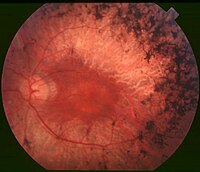
Photo from wikipedia
The aim of this retrospective, observational study was to examine the intraretinal locations of ruptured retinal arterial macroaneurysms (RMAs) and investigate the associations with the visual prognosis. Fifty patients (50… Click to show full abstract
The aim of this retrospective, observational study was to examine the intraretinal locations of ruptured retinal arterial macroaneurysms (RMAs) and investigate the associations with the visual prognosis. Fifty patients (50 eyes) with untreated RMA rupture who visited the Department of Ophthalmology at Kyoto University Hospital (April 2014–July 2019) were included. The intraretinal position of the ruptured RMAs relative to the affected retinal artery was examined using optical coherence tomography (OCT) and color fundus photography (CFP). The relative RMA positions were anterior to (anterior type, 44%), at the same level as (lateral type, 20%), or posterior to (posterior type, 34%) the affected artery. At the initial visit, the posterior type showed greater subretinal hemorrhage thickness than did the lateral and anterior types ( P = 0.016 and 0.006, respectively), and poorer visual acuity (VA) than did the anterior type ( P = 0.005). At the final visit, the length of the foveal ellipsoid zone band defect was longer ( P = 0.005) and VA was poorer ( P < 0.001) for the posterior type than for the anterior type. The intraretinal positions of ruptured RMAs vary, affect the thickness of foveal subretinal hemorrhage and predict future damage to the foveal photoreceptors. The visual prognosis may be poor for posteriorly ruptured RMAs.
Journal Title: Scientific Reports
Year Published: 2022
Link to full text (if available)
Share on Social Media: Sign Up to like & get
recommendations!